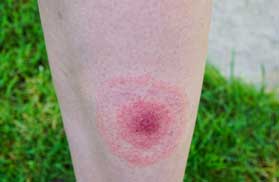Lyme Disease Treatment in Kittery, ME

Lyme disease is an infection caused by a blacklegged tick. This tiny tick causes huge health issues if you are bitten and you do not treat this right away. This article will explore who is a risk for Lyme disease, how to identify a tick bite, the prevention of tick bites, the symptoms of Lyme disease, the medical treatment protocol for Lyme disease, and the recovery from Lyme disease.
Who Is at Risk for Lyme Disease?
If you live in a wooded area, or spend a lot of time outdoors, especially in the states of the coastal northeast, Mid-Atlantic states, Wisconsin, Minnesota, northern California, Asia, Europe or South America, you can be exposed to the blacklegged ticks that carry Lyme disease. If your home is built in a formerly rural area that displaces large deer populations, you are also at risk for Lyme disease. Animals that can carry Lyme disease include:
- White-footed field mice
- Deer
- Raccoons
- Opossums
- Skunks
- Weasels
- Foxes
- Shrews
- Moles
- Chipmunks
- Gophers
- Squirrels
- Horses
What Does a Lyme Disease Tick Bite Look Like?
In 70 to 80% of Lyme disease cases, there is an appearance of “erythema migrans,” or a very pronounced tell-tale rash; typically, your skin will look like a red bull's eye, or target-shaped rash. There will often be a pustule center to this bull's eye. Please see the photo in this article to familiarize yourself with its appearance. Please note that other bites—such as spider bites—can appear like this, so if your rash has this appearance, please see your healthcare provider and get tested right away.
What Are Lyme Disease Symptoms?
Depending on how early or late in its spread that you catch the disease, you can experience the following symptoms:
- A large, red, target-shaped expanding rash surrounding the site of the tick bite
- A stiff neck
- Flu-like symptoms such as chills, fever, headaches, fatigue, muscle aches and joint pain
- Nerve problems
- Arthritis (especially in the knees)
- Temporary paralysis of facial muscles (Bell's palsy)
- Numbness, pain or weakness in the limbs
- Memory loss
- Difficulty focusing or concentrating
- Irregular or slow heartbeat
- Dizziness
- Shortness of breath
- Eye inflammation
How is Lyme Disease Identified?
If you don't have the target-shaped red rash (which happens in 25% of cases), but you're experiencing symptoms, what's next? Three to four weeks after your symptoms appear, the doctor will order a blood test to see if you have antibodies against the bacteria. There are two types of blood tests, the ELISA, and the Western Blot. The Western Blot is ordered when the ELISA blood test is inconclusive.
If you are experiencing nervous system symptoms, the next step in diagnosing you is performing a spinal tap, where spinal fluid is removed from your spinal canal to detect brain and spinal cord inflammation, and search for Lyme disease bacterium in your spinal fluid.
How is Lyme Disease Treated?
The more quickly Lyme disease is addressed, the better the outcome. The typical treatment protocol calls for two to four weeks of doxycycline or amoxicillin tablets, taken orally. Beyond two weeks, this treatment is not more effective. Children age 9 or younger and pregnant or lactating women are treated with amoxicillin or penicillin because doxycycline can stain permanent and developing teeth in children. If you are allergic to penicillin, you will be given erythromycin or related antibiotics. Those with heart symptoms are often treated with Rocephin, Claforan, or an intravenous penicillin for two weeks. Most patients will not see long-term heart damage.
How Do I Prevent Tick Bites?
Aside from wearing tick repellant, you can minimize the likelihood of ticks on your property by adhering to the following suggestions:
- Keep your lawn mowed and well-manicured
- Prune your trees, clear excess brush and leaf litter
- Keep your children's play sets away from the woodland edge of your yard
- Landscape with gravel pathways, mulch, decking, stone, tile and other hardscapes around your home
- Wildflower meadows and herbal gardens also detract ticks and are a grass alternative
- Fence your yard to discourage deer from entering
- Plant deer-resistant plants such as marigolds, shrubs and trees, annuals and perennials
- Clean up stonewalls and hiding places that provide shelter for mice and chipmunks
- Keep your firewood piles far away from your home
- Apply pesticides or insecticides that kill ticks, preferably in mid-May through early June.
You can request more information about Lyme disease today by calling (207) 536-9661 or contact Dr. Johanna Mauss online.
Vibrant Health Natropathic Medical Center
Address
3 Riverside DriveGreenland, NH 03840
(207) 536-9661
vibranthealthnaturalmedicine.com/
Hours
Mon:
8:30 am - 5:00 pm
Tue:
9:00 am - 5:00 pm
Wed:
10:30 am - 5:00 pm
Thu:
9:00 am - 5:00 pm
Fri:
10:00 am - 4:00 pm
Sat:
Closed
Sun:
Closed


